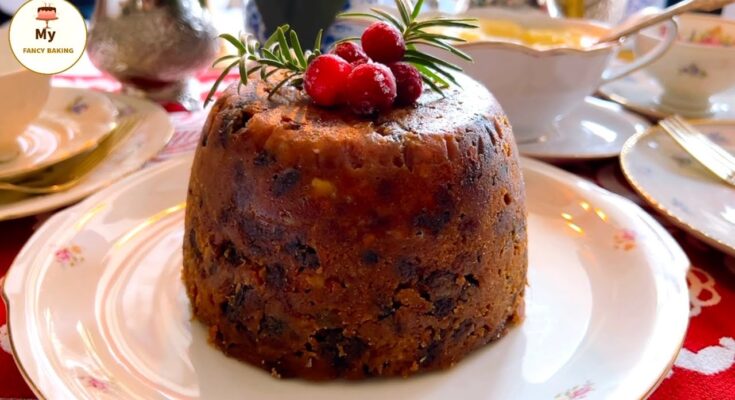Christmas Pudding Recipe: Christmas pudding, often called plum pudding or figgy pudding, is a rich, dense dessert that has long been a festive tradition in many homes. It traces its roots back to medieval England and is synonymous with holiday cheer. Traditionally made weeks before Christmas Day, the pudding matures over time, allowing flavors to deepen and develop. Each bite carries the warmth of dried fruits, the richness of suet or butter, the kick of alcohol, and the cozy blend of spices.
Despite its lengthy preparation time, the effort is more than worth it. Not only does it taste divine, but the process itself becomes a cherished seasonal ritual. Whether you’re a first-timer or looking to refine your annual bake, this step-by-step guide will help you craft the perfect Christmas pudding to wow your guests.
Ingredients You’ll Need
Getting your ingredients right is the first step to ensuring your pudding turns out delicious and authentic. Here’s everything you need, broken down for clarity.
Dry Ingredients
- 200g currants
- 200g raisins
- 100g sultanas
- 100g mixed candied peel
- 100g chopped dates or figs
- 100g soft breadcrumbs
- 100g plain flour
- 100g dark brown sugar
- 100g suet or grated frozen butter
- 1 tsp ground cinnamon
- 1 tsp mixed spice
- ½ tsp grated nutmeg
- ½ tsp ground cloves
- Pinch of salt
These dry ingredients create the base flavor and texture of your pudding. The dried fruits bring natural sweetness, while the spices add that iconic Christmas warmth. Breadcrumbs help in binding, and suet (or butter) adds moisture and richness.
Wet Ingredients
- 2 large eggs
- 1 apple, peeled and grated
- Juice and zest of 1 orange
- Juice and zest of 1 lemon
- 100ml dark beer or stout (optional)
- 100ml brandy or dark rum
The wet ingredients help bind the mixture and enhance its moisture and taste. Alcohol acts as a preservative and flavor booster, making your pudding taste better over time. However, you can make it non-alcoholic by replacing booze with fruit juice or tea.
Optional Add-Ins
- 50g chopped nuts (almonds or walnuts)
- 50g dark chocolate chips
- 1 tbsp molasses or black treacle
These optional add-ins can elevate your pudding to the next level, adding a twist of flavor and texture.
Tools and Equipment Required
Before you begin, gather all the necessary tools. Being organized will make the process smoother and more enjoyable.
- Large mixing bowl
- Measuring cups and spoons
- Wooden spoon
- Grater
- Pudding basin (1.2-liter size)
- Greaseproof paper
- Aluminum foil
- String
- Large pot with lid for steaming
- Trivet or inverted saucer (to place in the pot)
With your tools ready and ingredients prepped, you’re now set to dive into the magical process of making your own Christmas pudding.
Preparing the Fruit Mixture (Soaking Process)
This step is crucial and should ideally be done the night before.
Step-by-Step:
- In a large bowl, combine the raisins, currants, sultanas, chopped dates, and candied peel.
- Add the orange juice and zest, lemon juice and zest, and your alcohol of choice (brandy, rum, or dark beer).
- Stir everything well so that the fruit is evenly coated.
- Cover the bowl with cling film and let it sit overnight at room temperature.
Why This Step Matters: Soaking the fruit allows it to absorb the liquid, plump up, and soften. This not only improves the texture but also ensures a moist pudding with deeply infused flavors.
Mixing the Batter
Once your fruits are ready, it’s time to bring everything together into a cohesive batter.
Step-by-Step:
- In a large bowl, sift the flour and mix it with breadcrumbs, brown sugar, spices, and salt.
- Add the suet or grated butter and stir until well distributed.
- Stir in the soaked fruits along with any remaining soaking liquid.
- Grate in the apple for moisture and natural sweetness.
- Crack in the eggs and stir until the mixture becomes thick and sticky.
- Finally, add in any optional extras like nuts, chocolate chips, or treacle.
Consistency Check: The mixture should be heavy and moist but not too runny. It should drop from a spoon with a little encouragement, not pour.
Pro Tip: Everyone in the house should give the mixture a stir for good luck—that’s the tradition!
Assembling the Pudding
Now that your mixture is ready, it’s time to assemble the pudding and get it ready for steaming.
Step-by-Step:
- Grease Your Pudding Basin: Use butter or a neutral oil to grease the inside of your pudding basin thoroughly. This prevents sticking and helps with easy removal later.
- Fill the Basin: Spoon the pudding mixture into the basin, pressing it down gently with the back of a spoon to eliminate air pockets. Leave about 1 inch (2.5 cm) of space from the top to allow for expansion during steaming.
- Cover the Top: Place a circle of greaseproof paper (parchment paper) over the surface of the pudding.
- Seal with Foil: Cover the entire top of the basin with a double layer of foil, pleated in the center to allow for expansion. Tie it tightly with string around the edge of the basin.
- Create a Handle: Use additional string to create a handle across the top. This makes it easier to lift the basin out after steaming.
Why It Matters: Properly sealing your pudding is key to avoiding water from seeping in during the steaming process, which would ruin the texture.
Steaming the Pudding
Steaming is the traditional way to cook Christmas pudding and is essential to achieving that dense, moist consistency.
Step-by-Step:
- Set Up Your Pot: Place a trivet, metal rack, or an inverted saucer at the bottom of a large pot. This ensures the pudding isn’t in direct contact with the heat source.
- Add Water: Pour boiling water into the pot until it reaches halfway up the side of the pudding basin.
- Insert the Pudding Basin: Carefully lower the covered pudding basin into the pot.
- Steam Gently: Cover the pot with a tight-fitting lid and steam the pudding over low heat for 6–8 hours. Check every hour to ensure the water hasn’t evaporated and top up with boiling water as needed.
Steaming Tips:
- Don’t let the water touch the lid of the basin.
- Keep the heat low and steady to prevent boiling over.
Why It Matters: Steaming slowly cooks the pudding while locking in moisture, giving it that rich, indulgent texture.
Storing the Pudding
A big part of what makes Christmas pudding so special is that it’s made in advance—sometimes even a month or two before Christmas Day.
Storage Guide:
- Let It Cool: After steaming, allow the pudding to cool completely in the basin.
- Re-cover It: Replace the used foil and paper with a fresh covering, just like before.
- Store in a Cool, Dark Place: Store the pudding in a pantry or cupboard. It will mature over time, and the flavors will intensify beautifully.
- Shelf Life: Properly stored, the pudding can last for months due to its high sugar and alcohol content.
Bonus Tip: Some traditionalists even “feed” their pudding once a week with a tablespoon of brandy to keep it moist and flavorful.
Reheating and Serving Suggestions
When Christmas Day finally rolls around, it’s time to reheat and enjoy your pudding.
Reheating Instructions:
- Steam Again: The best method is to steam the pudding again for 2 hours, using the same setup as before.
- Microwave Alternative: If you’re short on time, slice and microwave individual portions for 1–2 minutes, covered with a damp paper towel.
Serving Ideas:
- Brandy Butter: A classic topping made with butter, icing sugar, and brandy.
- Custard or Cream: Pour over hot custard or fresh cream to complement the richness.
- Flaming Finale: Pour a few tablespoons of warm brandy over the pudding and light it for a show-stopping presentation!
Pro Tip:
Make sure to dim the lights before lighting the pudding—it’s a dramatic and festive moment!
Christmas Pudding Variations
Every family seems to have their own take on Christmas pudding, and there are plenty of variations to suit different tastes and dietary needs. Whether you’re avoiding gluten, skipping the alcohol, or simply want to mix things up, there’s a version for everyone.
Popular Variations:
- Gluten-Free Pudding: Substitute regular flour with gluten-free flour and make sure your baking powder is also gluten-free. Use gluten-free breadcrumbs for consistency.
- Vegan Pudding: Swap out suet or butter for vegetable suet or vegan margarine. Use flax eggs (1 tbsp flaxseed + 2.5 tbsp water per egg) instead of real eggs.
- No-Alcohol Pudding: Replace brandy or beer with strong brewed tea, apple juice, or orange juice. You’ll still get deep, rich flavors without the booze.
- Luxury Pudding: Add chopped dark chocolate, gold-dusted nuts, or even bits of caramel for a gourmet twist.
Flavor Swaps:
- Use dried cranberries or cherries instead of raisins.
- Add a splash of vanilla extract or almond essence.
- Use different liquors like sherry, port, or amaretto.
Why It Works: These variations let everyone enjoy this festive dessert while still keeping the heart of tradition alive. Plus, they’re great conversation starters at the holiday table!
Tips and Tricks for the Perfect Pudding
Making Christmas pudding might seem daunting at first, but a few insider tips can make the process smoother and more successful.
Top Tips:
- Don’t Rush the Soaking: Give the dried fruit ample time to absorb the liquid—it enhances flavor and texture.
- Use Fresh Spices: Spices lose potency over time. Fresh cinnamon, nutmeg, and cloves will give your pudding a richer, more aromatic taste.
- Mix Well, But Not Too Much: Overmixing can make the pudding dense in a bad way. Stir until combined, no more.
- Steam Slowly: A gentle, slow steam ensures an evenly cooked pudding. Too hot, and you risk drying it out or burning the base.
- Let It Mature: Store your pudding for at least 2–4 weeks before eating. This aging process develops deeper and richer flavors.
- Keep It Moist: While storing, check your pudding occasionally. If it looks dry, brush it with a little brandy or juice.
Extra Advice:
- Mark your calendar to remind yourself when it’s time to reheat or feed the pudding.
- Double-wrap your pudding basin with foil to retain more heat during storage and reheating.
Common Mistakes to Avoid
Even seasoned bakers can run into hiccups. Here’s what to watch out for:
1. Not Soaking the Fruit Long Enough: Dry fruits that haven’t had time to soak can draw moisture from the batter, resulting in a dry pudding.
2. Overfilling the Basin: Leave space for expansion—otherwise, you’ll end up with a sticky mess.
3. Improper Sealing: If steam or water gets inside the basin, it can ruin the pudding’s texture. Always double-wrap with foil and tie it securely.
4. Under-Steaming: Cutting the steam time short leaves the pudding raw in the center. Stick to the full 6–8 hours.
5. Skipping Storage Time: Eating the pudding too soon means you miss out on the complex flavors that develop with age.
Quick Fixes:
- If your pudding is too dry, serve it with a rich sauce like custard or add a splash of brandy before reheating.
- A soggy pudding? Likely due to water leakage. Use a new basin and try again—you’ll learn something every time!
Nutritional Information
While Christmas pudding isn’t exactly diet food, it’s full of real ingredients and festive flavors. Here’s a rough idea of what you’re indulging in:
| Nutrient | Per Serving (100g) |
|---|---|
| Calories | 320 kcal |
| Carbohydrates | 55g |
| Sugars | 35g |
| Fat | 10g |
| Saturated Fat | 4g |
| Protein | 3g |
| Fiber | 3g |
| Sodium | 150mg |
Notes:
- Calories and fat can vary based on ingredients (suet vs. butter, nuts, and alcohol).
- It’s a dense dessert, so small servings go a long way.
FAQs about Christmas Pudding Recipe
1. Can I make Christmas pudding without alcohol?
Absolutely! Swap alcohol for strong tea, apple juice, or orange juice. It still tastes amazing and is great for all ages.
2. How long does Christmas pudding last?
When stored properly in a cool, dark place, it can last for months—sometimes even up to a year.
3. Can I freeze Christmas pudding?
Yes, you can freeze it for up to 6 months. Just wrap it well in foil and place it in a freezer-safe container.
4. What’s the best way to reheat Christmas pudding?
Steaming for 2 hours is traditional, but you can also microwave slices individually for a quick fix.
5. Why does my pudding taste bitter or burnt?
This could be due to over-steaming or using old, burnt sugar. Always steam on low and use fresh ingredients.
Conclusion
There you have it—the complete, step-by-step guide to making the perfect Christmas pudding. Whether you stick with tradition or throw in your own twist, this dessert brings a sense of occasion and nostalgia to the holiday table. Sure, it takes a bit of time and effort, but that’s part of the magic. It’s not just about the end result—it’s about the memories made along the way.
So light it up, spoon it out, and enjoy every bite of your homemade masterpiece. Merry Christmas and happy baking!



